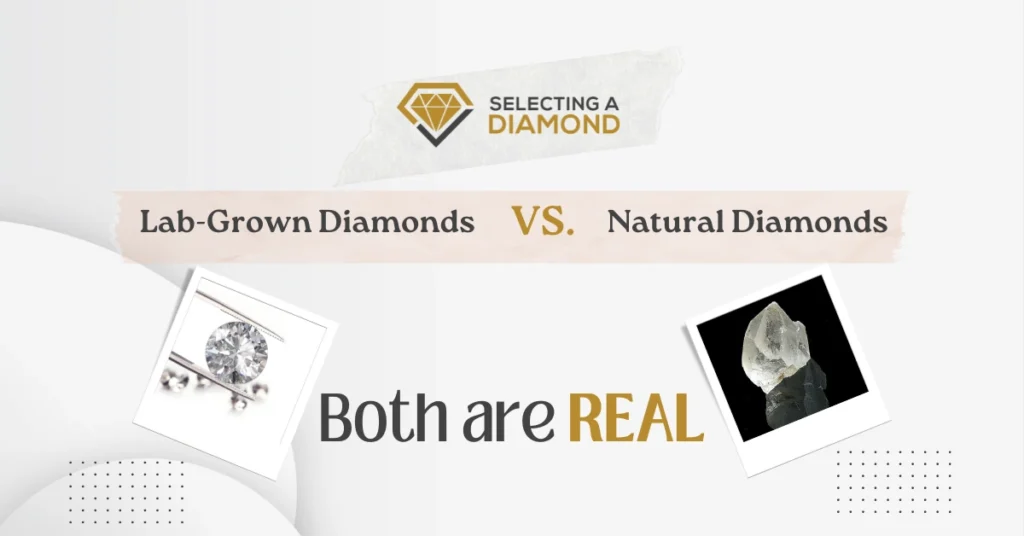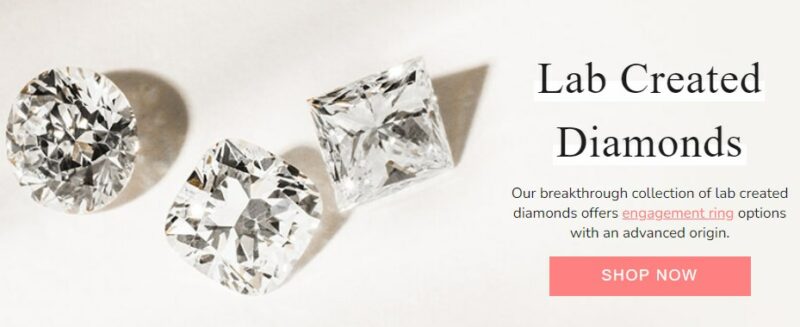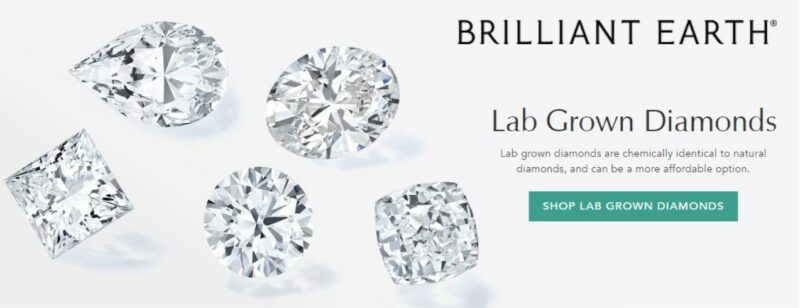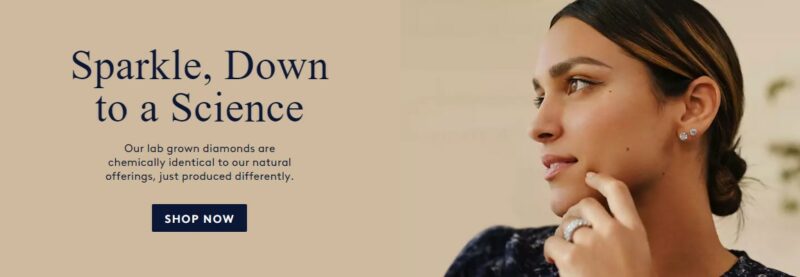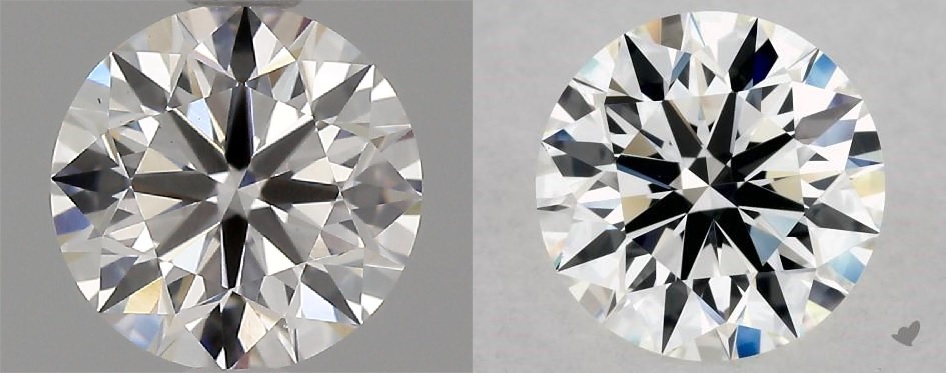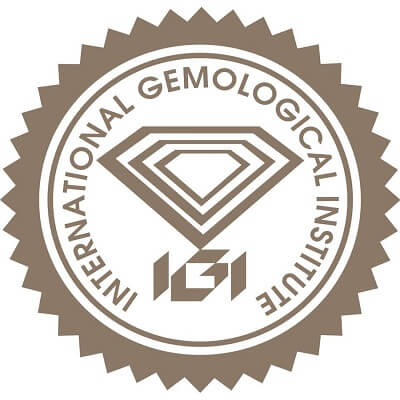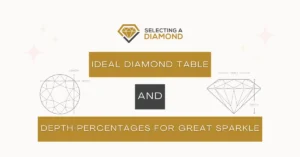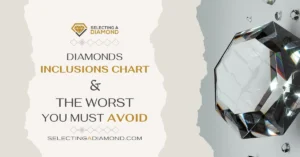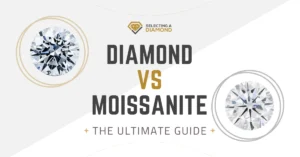We may earn a commission when you purchase through our affiliate links, at no extra cost to you. This helps support our work and allows us to continue providing unbiased, expert diamond advice.
Considering investing $2,000 or $5,000 in a diamond? This price difference is the most obvious distinction between a lab-grown and a natural gemstone. But there’s more to it—can you spot the differences?
Are you sure about identifying which one is which?
Let’s break it down for you. While both types of diamonds showcase the same traits in terms of the 4Cs, the lab-created variant costs $2,260 at James Allen, while its natural counterpart commands a price tag of $5,500.
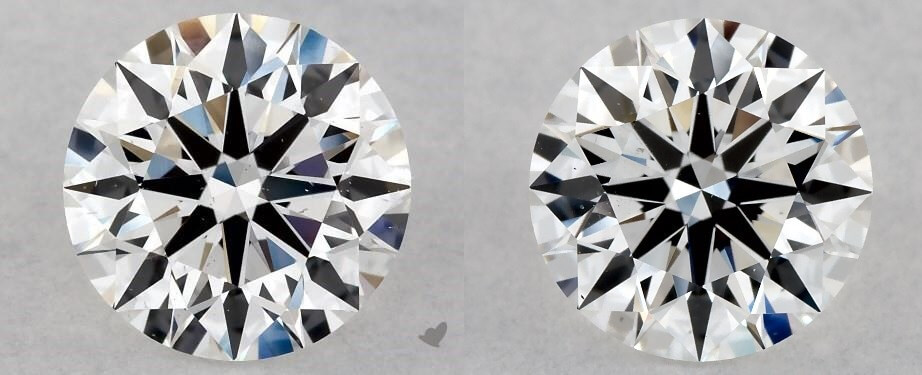
As depicted on the diamond listings, the one on the left is the natural diamond, while the lab-created gem stands on the right.
The allure of lab-grown diamonds is on a steady rise, especially among the younger generation. Retailers are taking note of this trend and are increasingly showcasing these gemstones to meet the growing demand.
A relatively fresh face (although not entirely new since we’re talking about 2021) in the lab-grown diamond arena is James Allen, standing as the largest online diamond retailer with an impressive inventory of over 40,000 diamonds.
They have successfully outshone Brilliant Earth, the former leader in the synthetic diamond domain, which now boasts a bit over 38,000.
As the name implies, lab-grown, lab-created, man-made, or synthetic diamonds are crafted with precision in a controlled lab environment. The procedures employed to produce them are rigorously controlled and executed, ensuring a high-quality outcome every time.
What are Lab-Grown Diamonds?
Lab-grown diamonds, alternatively known as synthetic or man-made diamonds, are indeed a marvel of modern science. Unlike their natural counterparts unearthed from the depths of the earth, these diamonds are meticulously crafted in laboratories.
Yet, they share the same physical, chemical, and optical properties with natural diamonds, courtesy of their identical building block: pure carbon crystallized in an isotropic 3D form.
These lab-crafted sparklers boast the same level of hardness, brilliance, and fire as the mined ones and are graded on the identical scale of the prestigious 4Cs: Cut, color, clarity, and carat.
How are Lab-Grown Diamonds Made?
The journey of a lab-grown diamond from inception to completion is a fascinating one, achieved through two notable techniques. Both methods aim to mimic the earth’s crust conditions where diamonds naturally form, resulting in creations that closely resemble natural diamonds, albeit with minor differences.
1. High Pressure, High Temperature Process
The HPHT method strives to recreate the extreme conditions prevalent deep within the earth, where diamonds naturally come into being. The process begins by placing a diamond seed in a chamber. What follows is the application of immense heat and pressure, akin to the conditions found far beneath the Earth’s mantle. Over time, the carbon atoms in the chamber crystallize around the seed, nurturing the growth of a diamond.
2. Chemical Vapor Diffusion Process
Taking a different tack, the CVD method places a diamond seed crystal within a sealed chamber filled with a carbon-rich gas. As the chamber heats up to exceedingly high temperatures, the gas disintegrates, liberating carbon atoms. These free carbon atoms bond with the diamond seed, building up layer by layer, progressively growing a diamond.
Both the HPHT and CVD techniques have the potential to churn out diamonds with properties either identical or extremely close to those of natural diamonds, though each process may result in slight variations.
These lab-engineered diamonds mirror the optical and physical allure of their natural counterparts and share a chemical identity. The specific conditions under which they are grown lead to some variation even among lab-grown diamonds.
As the technology behind lab-grown diamonds continuously evolves and refines, the future holds immense promise. Industry pundits and stakeholders anticipate that the burgeoning presence of lab-grown diamonds in the luxury market will become more pronounced in the forthcoming years, as advancements in these crafting methods persist.
Lab-Created Diamonds vs. Natural (aka Real) Diamonds
The world of diamonds is as multifaceted as the gems themselves, with the recent inclusion of lab-created diamonds adding to its brilliance. Both lab-created and natural diamonds carry the prestigious title of being diamonds, thanks to their identical crystalline structure comprised of carbon atoms which bestows upon them their characteristic hardness and shine.
Despite sharing a name and core structure, the tale of their origin and journey to adornment unveils significant distinctions between the two.
1. Origin
Natural diamonds are nature’s marvels, taking billions of years to form under the high pressure and high temperature realms about 100 miles beneath the Earth’s crust, only to be unveiled by earthly volcanic activities. Contrarily, lab-created diamonds are modern-day marvels, crafted within weeks in laboratories using cutting-edge technologies that mimic the natural diamond-formation conditions.
2. Environmental Impact
The quest for natural diamonds often comes at an environmental cost, encompassing soil erosion, deforestation, and ecological disruption. Lab-created diamonds, on the flip side, pose a lesser environmental burden, circumventing large-scale mining debacles. However, the energy consumption required for their production is substantial.
3. Ethical Concerns
The shadow of human rights infringements, including child labor and conflict funding, has long loomed over the natural diamond industry, although measures like the Kimberley Process aim to alleviate these issues. Lab-created diamonds, birthed in controlled lab environments, steer clear of such ethical quagmires.
4. Price
The allure of lab-created diamonds is not only in their sparkle but also in their relatively lighter price tag compared to natural diamonds. The lesser production cost and absence of a rarity factor contribute to their affordability.
5. Value
The rarity and uniqueness of natural diamonds often render them better value retention over time. With lab-created diamonds becoming more prevalent, their value trajectory may not parallel that of natural diamonds, although they remain precious.
6. Quality and Appearance
The finesse of cut, polish, and the revered 4Cs (Carat, Cut, Color, Clarity) applies to both natural and lab-created diamonds, yielding exquisite gemstones. However, minor disparities in appearance or inclusions might surface depending on the specific crafting process of lab-grown diamonds.
Lab-created diamonds and natural diamonds cater to differing sentiments and considerations. While the former offers a more ethical and economical choice with identical dazzle, the latter remains unparalleled in its narrative of rarity and natural charm.
Each holds its own allure, engaging different clientele based on priorities and values.
Here comes a question about the “reality” of lab-grown diamonds…
Are Lab-Grown Diamonds Real Diamonds?
Indeed, lab-grown diamonds are real diamonds. The essence of their being is carved from the same elemental core as natural diamonds: pure carbon, meticulously arranged in a crystalline structure. They share the same realm of physical, chemical, and optical characteristics with natural diamonds, rendering them true to the core.
The harmony of chemical and physical attributes between lab-grown and mined diamonds translates into a uniform display of hardness, refractive index, and that mesmerizing sparkle which diamonds are revered for. The artistry involved in cutting and polishing them mirrors that of natural diamonds, and they are measured against the same revered standards, the 4Cs: carat, cut, color, and clarity.
While there could be minute differences in trace elements or crystal growth patterns—detectable only by specialized equipment—these variances bear no impact on the diamond’s appearance or durability. Hence, from a consumer’s perspective, a lab-grown diamond embodies the essence and allure of a real diamond.
Now, envision two diamonds side by side—one mined and the other crafted in a lab.
The sparkle, the allure, and the timeless elegance remain consistent, challenging even the discerning eye to spot a difference. The narrative of their origin might diverge, but the luxurious aesthetic and captivating sparkle bind them in a tale of authentic beauty.
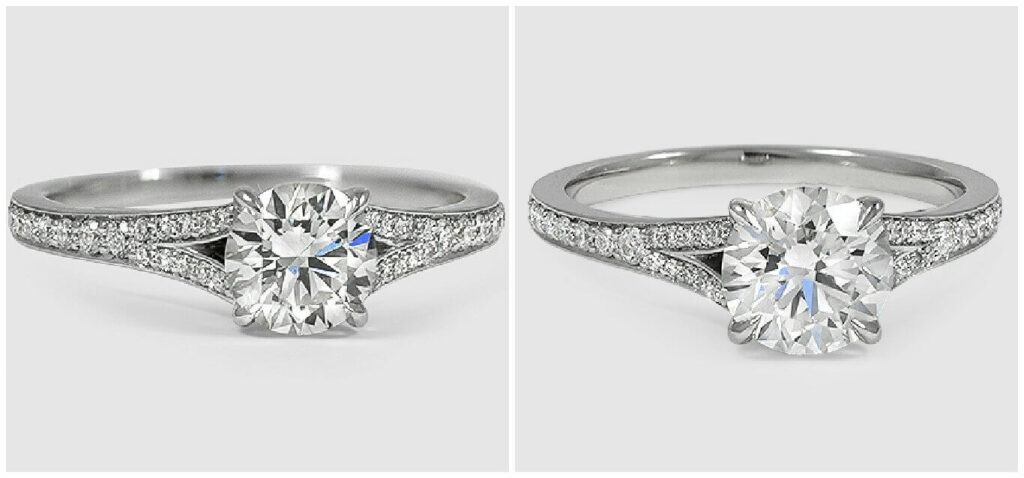
Lab-Grown Diamonds Adaptation
Not too long ago, say in 2010 or even as recent as 2015, the hunt for a diverse selection of lab-created diamonds could have easily led you into a maze with sparse rewards, whether you scoured online or paced through the aisles of physical diamond stores.
Fast forward to the last five years, and the diamond landscape has glittered up with a welcoming sheen for lab-created diamonds. A monumental testament to this change is none other than Blue Nile unfurling its collection of lab-created diamonds.
In fact, we had foreseen this shift. Here’s a nugget from the past—a screenshot from a post we articulated four years ago:
Circling back to the present day in 2023, propelled by soaring global appetites and the increasingly attractive affordability of lab-created diamonds, a majority of eminent diamond retailers have gracefully extended their troves to include these man-made marvels. Here’s a glittering roster of such retailers diving into the lab-created diamond wave:
- James Allen
- Blue Nile
- Whiteflash
- Brilliant Earth
- Clean Origin
And the list twinkles on. We will delve deeper into the offerings of some of these retailers further down, but the broader picture already beams clear—the embrace of lab-created diamonds is widening, fueled by escalating demand and the resounding affirmation of their authentic charm.
Are Lab-Grown Diamonds Worth the Money?
With a promise of affordability and ethical sourcing, these man-made marvels have been catching the eye of the conscious consumer. But the question on everyone’s lips is:
Are lab-grown diamonds truly worth the investment? The answer lies in what you cherish most – cost, sustainability, ethical procurement, or the undying allure and physical attributes of a natural diamond.
Over the past decade, the price tag on lab-grown diamonds has danced to its own erratic rhythm. Initially waltzing in close proximity to the cost of natural diamonds, these “engineered” stones now often twirl around the price range of 50% less than their earth-mined counterparts.
This price drop has flung open the doors for buyers to either pocket the difference or venture towards acquiring a larger stone or better quality specifications without breaking the bank.
This dramatic shift in pricing can be credited to the dog-eat-dog nature of the diamond market, steered by a handful of dominant players, the notorious De Beers amongst them.
If you happened to have purchased a lab-grown diamond during the years 2017 or 2018, you might have noticed its value pirouetting downwards, choreographed by the principles of supply and demand, and the swelling array of choices offered by retailers.
Now, sliding the spotlight towards environmental and ethical facets, lab-grown diamonds dance to a much more righteous tune. Often hailed as the sustainable, ethically sourced heirs to mined diamonds, these synthetic stones sidestep the hefty environmental footprints and the murky ethical waters associated with traditional diamond mining.
However, before you take a bow and settle for a lab-grown diamond, consider the encore – the resale value. Typically, these engineered gems face a lukewarm applause on the resale stage, overshadowed by the enduring rarity and perceived intrinsic value of natural diamonds.
In the grand finale, the worthiness of lab-grown diamonds pirouettes around your personal values. If your heart beats for affordability, ethical sourcing, and environmental sustainability, and you wish to embrace the diamond for its sparkle rather than its resale value, then yes, a standing ovation is in order – lab-grown diamonds could very well be your heart’s desire.
Best Places to Buy Lab Created Diamonds?
10 years ago, it would take you a lot of research to find an online stores that sells lab grown diamonds, but today, it’s the other way around, you will find a hard time browsing an online store that doesn’t sell lab created diamonds.
We’ve written a dedicated article about the Best 8 Places to Buy Lab Created Diamonds, so feel free to check it for a detailed list about where to buy lab created diamonds.
But today for short, here are the top 3 stores that we recommend:
1. James Allen
James Allen’s diverse collection and competitive prices make it a go-to for many diamond shoppers. The site showcases over half a million diamonds with HD 360-degree imaging and 40x magnification.
Among their 54,000 lab-grown options, you’ll find a diamond that exactly fits your budget, style, and preferences.
2. Brilliant Earth
Brilliant Earth sets the pace in the jewelry industry with its strong environmental commitment and array of lab-grown diamonds.
These diamonds provide customers with ethical, sustainable alternatives to traditionally mined diamonds. Their dedication to ethical practices and transparency has made Brilliant Earth a favorite among those seeking quality lab-created diamonds.
Currently, they offer an impressive selection of over 228,000 lab-grown diamonds.
3. Blue Nile
Blue Nile is a major player in the online diamond retail space.
They eventually embraced market demands and introduced lab-grown diamonds to their offering.
Now, alongside their traditional diamonds, Blue Nile features high-quality, ethically-sourced lab-grown diamonds. This wide range caters to various budgets and preferences, with over 12,500 lab-created diamonds priced staring as low as $300.
A lot of other merchants are also well-known for selling lab-grown diamonds, like Clean Origin, Whiteflash, VRAI (previously Diamond Foundry), and others.
James Allen Lab Created Diamonds Review
James Allen took a bold step into the realm of lab-created diamonds in the summer of 2019, expanding their offerings with a premium selection of lab-grown diamonds.
Initially, their inventory oscillated between 4,500 to 12,000 diamonds, but they significantly upped their game by 2021, flaunting a whopping 40,000 diamonds. Fast forward to 2023, and they now boast a staggering inventory of 54,000 lab-created diamonds!
With such a vast array, finding a lab-grown diamond that fits your budget is almost a sure bet with James Allen.
Pricing and Certification
The price spectrum at James Allen is rather broad, with a 0.7-carat diamond starting at a modest $580, going all the way up to a premium 4-carat D Color VVS1 lab-grown diamond tagged at $63,000. To put things in perspective, a similar mined diamond could set you back anywhere between $200,000 to $250,000.
When it comes to certification, James Allen doesn’t skimp. They offer diamonds graded by reputable labs including IGI, GCAL, and GSI, with a significant 95% of their inventory graded by IGI.
Why James Allen for Lab Created diamonds?
The perks of securing a lab-created diamond from James Allen are numerous, but the highlights surely include their cutting-edge imaging technology, flexible payment options, dependable customer service, and a solid money-back guarantee.
To give a glimpse into the caliber of James Allen’s imaging technology, consider comparing two nearly identical diamonds, one from Brilliant Earth and the other from James Allen. The quality difference is noticeable and speaks volumes.
Although we’re not here to exclusively promote James Allen, our ongoing recommendation for them stems from their established track record and the positive reviews we’ve received from our readers.
Best Lab Grown Diamonds Certification
Certification plays a pivotal role in verifying the quality of the diamond you’re eyeing. Venturing into a diamond purchase without a certificate is akin to sailing in stormy waters, and the safest harbor in such scenarios is the assurance from esteemed grading entities like GIA or AGS. Yet, when it comes to the frontier of lab-created diamonds, the grading narrative takes a different turn.
The grading stage saw a shift in acts over recent years; initially, both GIA & AGS took a step back from grading lab-grown diamonds. However, as the curtain of hesitation lifted, they began extending their grading expertise to these man-made sparklers.
This interim period opened the gates for other protagonists to claim the spotlight, a chance seized earnestly by IGI.
The International Gemological Institute (IGI) turned the tide of uncertainty to its advantage, laying down a robust grading framework and transparent standards for lab-created diamonds. This strategic move catapulted them to a stellar reputation in the lab-grown diamond arena.
Consequently, leading lab-grown diamond retailers like James Allen and Brilliant Earth now predominantly feature IGI-graded lab-created diamonds in their showcases.
To sum up, a diamond’s journey to your jewelry box should come with a certification tag from a credible lab. It’s essential to note, the grading compass varies from one lab to another; some like GIA and AGS hold a stringent lens, while others may tread a more lenient path.
Lab Created Diamonds FAQs
We will try to group most of the questions that anyone might ask about lab-grown diamonds.
Q: Unveiling the terminology: Lab-created, lab-grown, artificial, man-made, synthetic, or manufactured diamonds – what’s the difference?
A: All these terms are birds of a feather! They refer to diamonds that took their first breath not under the Earth’s crust, but within the well-controlled ambiance of a lab, thanks to the marvels of advanced technology.
Q: Are lab-created diamonds truly diamonds?
A: Absolutely! The term “lab-created” often gets misinterpreted as something opposing natural diamonds. However, this isn’t the case. Lab-created diamonds are every bit real, holding their ground under the scrutinizing eyes of certification labs just like their natural counterparts.
The only aspect setting them apart is their origin story – while one descends from the earth’s belly, the other is born in a lab!
Q: Why do lab-created diamonds carry a lighter price tag?
A:It boils down to availability. Lab-created diamonds are like stars in the city sky, whereas natural diamonds are the rare celestial bodies of a dark, rural night.
Q: Is it fair to label natural diamonds as overpriced?
A:Not quite. The price tag on natural diamonds is not whimsical; it’s a narrative of their rarity and the control on their availability in the market.
Q: Can GIA or AGS put a seal of authenticity on lab-created diamonds?
A: Indeed, GIA extends its certification services to man-made diamonds, albeit through a distinct report designed for them. IGI follows a similar path. However, as of now, AGS hasn’t extended its expertise to assess or certify lab-created diamonds.
Q: From where I can buy lab-grown diamonds?
A: The modern marketplace is brimming with both online and brick-and-mortar stores offering lab-created diamonds. Our scale tilts towards James Allen and second option to go to Brilliant Earth due to their superior image quality and technology.
Q: I want to buy it online, where can I find the best lab-created diamonds Online?
A: Your options are aplenty! James Allen reigns with a vast, unique collection, making it a prime online destination for lab-grown diamonds. Yet, Brilliant Earth is not far behind, showcasing an equally enticing array of lab-created gems ready to be clicked into your cart.
Q: Can someone tell the difference between a lab created diamond and a natural one?
A:The untrained eye, mine, yours, or anyone we know, won’t catch the tale of their origin. The tale-teller here is an expert gemologist armed with advanced tools like those developed by GIA, who can unveil the birth secret of a diamond – whether it sprung from nature’s lap or a lab’s cradle.
Q: How I can make sure I’m not getting ripped off?
A: Navigating through the gem market requires a compass of trust. That’s why anchoring your purchases in reputable online stores is a route we vouch for. Some murky waters in the walk-in stores realm may attempt to sell lab-created diamonds under the guise of natural ones. So, make it a rule of thumb to have the diamond’s original certificate under your scrutiny before it finds a spot in your treasure chest.
Q: Since no one can tell the difference, is it safe to buy a lab created diamond for my fiancée?
A:Absolutely! But transparency is key in this gem journey. Make sure your fiancée is in the loop about the lab-crafted nature of the diamond. Honesty, after all, is a jewel that never loses its sparkle.
Q: How much time it takes to create a diamond?
A: The marvel of technology has condensed the epic timeline of diamond creation to a mere 10 to 12 weeks in a lab. It’s a staggering stride when you place it against the backdrop of natural processes that take billions of years to sculpt a diamond.
Bottom line – Should you Buy a Lab created Diamond?
Choosing between a lab-created and a natural diamond is akin to standing at a crossroad where each path echoes your values, budget, and desires. Should your heart beat for environmental sustainability and value, a lab-created diamond may well be your gem of choice. These diamonds mirror their natural counterparts in both appearance and composition, albeit at a gentler price point.
On the other flip of the coin, if the rarity, age-old allure, and potential resale value of natural diamonds resonate with you, then meandering down the natural diamond route could be where your heart finds its sparkle. It’s a realm where every stone has a tale spun over a billion years, embodying the essence of rarity.
Both lab-created and natural diamonds carry their unique set of sparkles and shadows. Your choice should mirror the facets that shine brightest to you.
Now, should your wallet feel a bit light yet your desire leans towards the enigmatic charm of natural diamonds, fear not. A natural diamond can still nestle elegantly on your finger or dangle gracefully from your neck, without you chasing after a fortune.
By mastering the rhythm of the 4Cs – Cut, Carat, Color, and Clarity, you can tune into a diamond that dances gracefully with your budget.
Furthermore, arming yourself with insights on where to net the most dazzling diamond at a value that sings to your tune is key. With a dash of knowledge and a sprinkle of research, your dream diamond, natural or lab-created, is but a grasp away.
Still not sure where to buy your diamond?
We always recommend shopping diamonds online and created a Full guide to shop diamonds like a Pro.
Among online retailers, here are our favorite stores click their logo to visit store
-
James Allen:
Our favorite online store, best diamond imaging technology available today, comes with the largest collection with more than half a million loose diamonds.
-
Blue Nile:
Widest collection of loose diamonds of all sizes, great imaging technology for most of their inventory (hundreds of thousands of diamonds), great customer support.
-
Whiteflash:
Home Of A CUT ABOVE® Super Ideal Diamonds, they stand out from the crowd by offering premium diamonds cuts, tailored to those who love the details, at great prices too.

